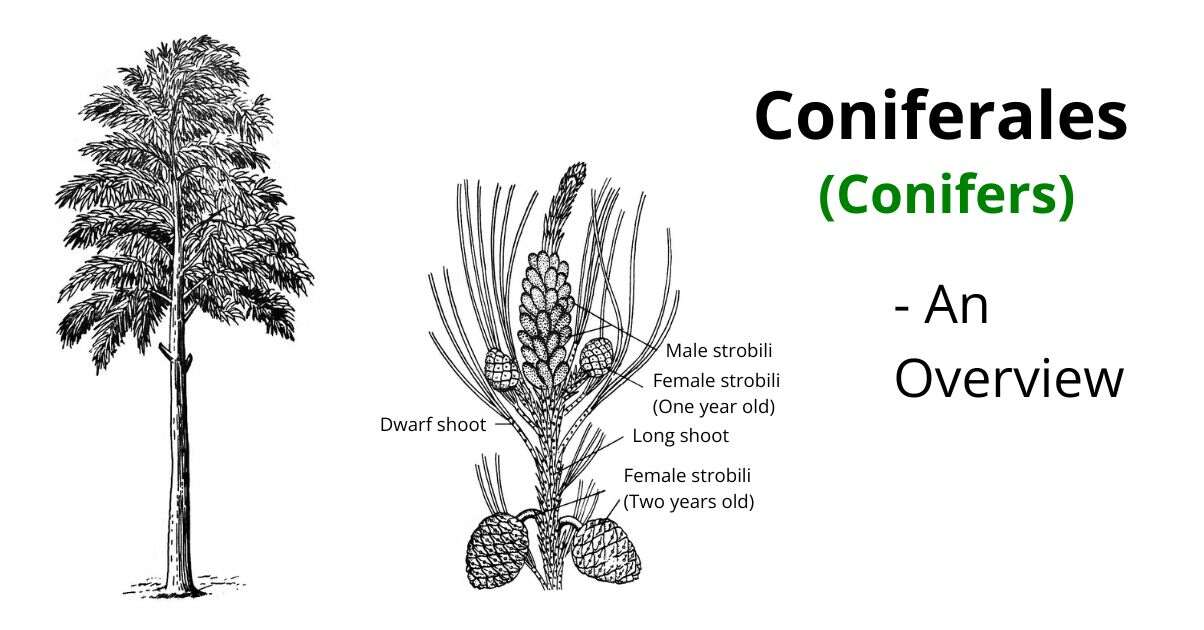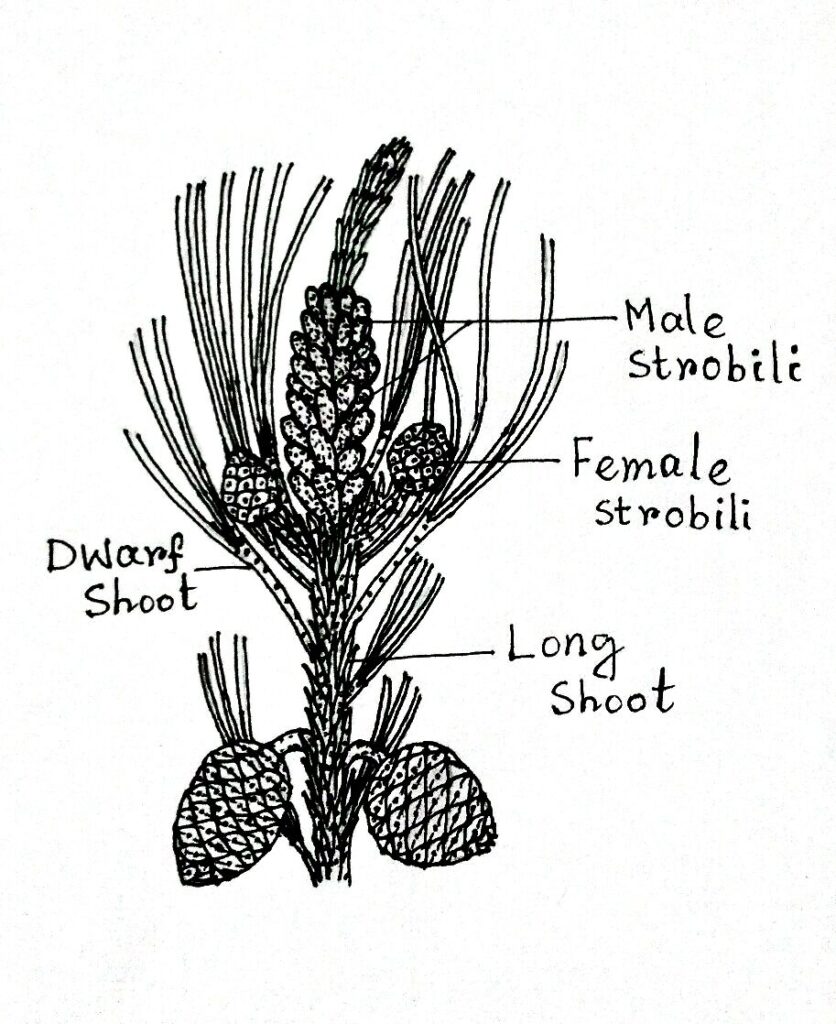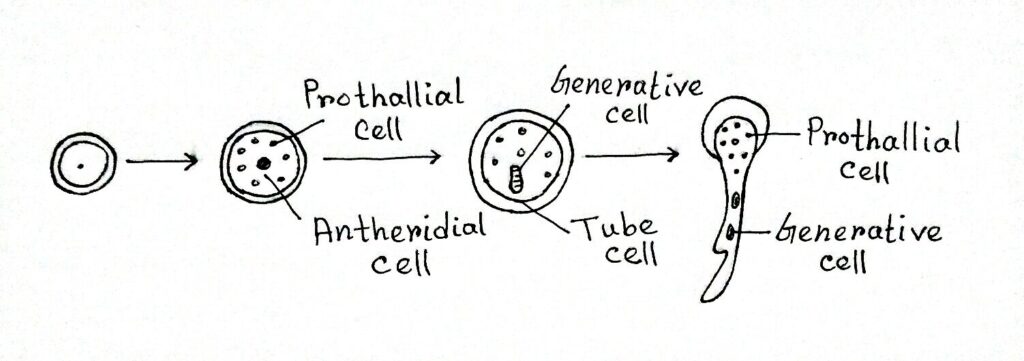Coniferales is a group of gymnospermic plants. The members of this group form the common conifers. It includes both fossil and present-day living genera. Coniferales reached their maximum development probably during the late Jurassic period or the early Cretaceous period and then it began to decline.
The members of Coniferales constitute dominant forest vegetation in the temperate parts of the world and regions of high altitudes. They are mostly trees with some shrubby species, the stem is much-branched. Leaves are dimorphic.

Distribution of Coniferales
- Order Coniferales contains more than 200 species.
- They are widely distributed throughout the temperate and sub-alpine regions of the Northern hemisphere.
- Also, conifers are found in Australia, Japan, New Guinea, Brazil, Argentina, and the Indian hills regions (West Himalaya).
- Examples: Some common genera of conifers are Pinus, Cedrus, Lorix, Abies, Arucaria, Podocarpus, Arucaria, Callitris, Actinoztrobus, etc.
Morphology of Coniferales
External Morphology
Stem
- The stem is erect, stout, cylindrical, and branched.
- In Pinus, the stem is covered with bark which is characteristic of different species.
- Branches are of two types dwarf or spur shoots (short branches of limited growth) and long shoots (long lateral branches of unlimited growth).
- The dwarf shoots develop in the axils of scale leaves and are devoid of apical buds.
Leaves
- Leaves are generally 15-30 cm long, open dichotomous venation, needle-like evergreens divided into four types midrib, needle, bifacial lanceolate, or linear leaves (in Cupressus), and foliose leaves (in Araucariaceae and Podocarpaceae).
- In Pinus, leaves are of two types: scale leaves (brown, small and thin) and foliage leaves (needle-like green simple).
- Scale leaves occur on long and as well as on dwarf shoots and fall off as the branches attain maturity.
- Although needle-like foliage leaves are borne only on dwarf shoots.
Root
- The root is long and branched.
- Pinus has a strong taproot system, which may persist or may be associated with stronger adventitious roots.
- Root hairs are scanty and ectotrophic mycorrhiza occurs.
Internal Morphology
Stem Anatomy
- In the transverse section, the stem shows a thin cortex, a large zone of vascular tissues, and a small pith.
- Epidermis and pericycle are not very distinct. The pith is parenchymatous.
- In Pinus, the epidermis is one layer thick and consists of tubular, closed compact cells, the outer walls are cutinized.
- The cortex is composed of parenchyma cells, resin ducts are present in the cortex.
- The vascular bundles are conjoint, collateral and endarch. Vessels are absent.
- In tracheid, bordered pits are spirally arranged which are uniseriate or multiseriate. Periderm develops due to secondary growth.
- Phloem does not have sieve tubes and companion cells.
Leaf Anatomy
- The anatomy of the leaf shows xerophytic structure.
- The outer walls of the leaf-epidermis are heavily cuticularised.
- It has sunken stomata below this sclerenchyma tissues are present.
- The mesophyll is divided into palisade and spongy tissues.
- The cells of mesophyll have ridges on the walls projecting inside the cell cavities known as arm palisades.
Internal Structure of Root
- The root in the transverse section shows an outermost piliferous layer (epiblema), a multilayered cortex composed of parenchyma, and a diarch to tetrach vascular cylinder.
- There is a single-layered epidermis which is followed by a pericycle.
- In Pinus, the root is mycorrhizal because of the presence of a fungus on the surface of the root forming ectotrophic mycorrhiza.
- Secondary growth is present.
Reproduction of Coniferales
In Pinus, the plant represents the sporophytic generation. The plant is monoecious (male and female sporophylls are borne on the same plant but in separate strobili). Flowers are unisexual. Male flowers are represented by microsporophylls and female flowers are represented by megasporophylls.

Staminate Strobilus
- Male strobilus is simple, they form compact and oval structures.
- In Pinus, male cones occur singly in the axils of scale leaves of long shoots replacing thereby dwarf shoots.
- The central axis is surrounded by sporophyll and bract are present.
- Different plants are different in size of strobili such as Juniperus 2 cm, Araucarnia 24 cm.
- In the sporophyll, sporangia are various in number like in Taxodium 2-5, Cupressus 3-6.
- Each microsporophyll consists of a short stalk and a leaf-like expended structure, the apex of which is slightly bent upwards in Pinus.
- A microsporangium is sessile and oblong in shape. It consists of a wall of several layers of cells.
- The development of the microsporangium is of the eusporangiate type.
- The mature microsporangium contains inside microspore mother cells surrounded by a sporangium wall and tapetum.
- Spore mother cells form microspores (pollen grains).
- The pollen grains are winged and yellow in color.
Ovulate Strobilus
- Female strobilus is similar to staminate strobilus but bracts and ovule are present.
- Different plants show different lengths of stobili like Pinus 60 cm, and Sequoia 1.5 cm.
- The cone is long in Abies while circulates or ovulates in Taxodium.
- In Pinus, the female cone is a hard, woody, and dry structure. It consists of a central axis upon which numerous megasporophylls are spirally arranged.
- The megasporophyll is shortly stalked and consists of a large ovuliferous scale and a bract scale.
- Each ovuliferous scale bears two inverted or anatropous megasporangia (ovules) on the surface near the base.
- Ovules are surrounded by an integument.
- The integument is fused with the nucellus at the basal region and opens at the top to form a micropyle, which opens in the pollen chamber.
- Each Megaspore mother cell forms four megaspores, only the lowermost one is the functional megaspore while others degenerate.
Gametophytes of Coniferales
Male Gametophyte
- Microspore is the first cell of the male gametophyte, which is provided with an outer exine and an inner intine.
- In Abietacae, microspores divide and form a prothalial and a large cell, which again divides and forms a second prothalial cell and an antheridial cell.
- The antheridial cell divides to form a generative cell and a tube cell.
- The generative cell further forms a body cell and a stalk cell.
- Pollen is transferred in the pollen chamber in five cells condition, where the pollen tube is formed and the body cell enters the pollen tube.
- In the pollen tube, the body cell divides and forms two male gametes.
- Prothallial cell is not present in Cupressaceae. So in the pollen, a generative and a tube cell is present. Later the generative cell forms a body and a stock cell.
- In Podocarpaceae 1-8 prothallial cells are present, while in Arucariaceae two prothalial cells, one stalk cell and one tube cell is present.

Female Gametophyte
- Megaspore is the first cell of the female gametophyte.
- Development of the gametophyte takes place entirely within the megasporangium.
- The functional megaspore enlarges in size.
- Free nuclear division occurs in megaspores and forms 1000 nuclei, due to the formation of the vacuole nuclei is arranged in the periphery.
- Then walls are formed between the nuclei.
- As a result cellular gametophyte is formed in which some cells work as archegonial initials. It divides to form archegonium.
- In archegonium, two neck canal cells, one ventral canal cell, and one egg are formed.
Fertilization
- Fertilization takes place after a year of pollination in Pinus.
- Pollen tube makes its way down until it reaches the neck of archegonium.
- The gametes are fused with the egg and formed a zygote.
Embryo Development
- In Abietaceae, the zygote is divided transversally into two cells.
- Upper tier divides to form an open and suspensor tier, while the lower forms embryo.
- In Pinus, the zygote is divided and forms 4 tiers of 4-4 cells which are rosette, open suspensor, and embryonal tier.
- Suspensor cell divides and forms primary and secondary suspensor. Which are differentiated into 4 embryos in each archegonium.
- In Sciodopitys 32 nuclei form lower, middle, and upper tiers. Lower form embryonal tier, middle form pro-suspensor tier while upper form open tier.
Seed Germination
- The embryo matures and forms the seed.
- After a period of rest, the seed germinates by epigeal means to form a new sporophytic plant.
Classification of Coniferales
Pilger (1926) divided Coniferales into six families;
- Taxaceae (genera- Taxus, Torreya)
- Podocarpaceae (genus- Podocarpus)
- Araucariaceae (genera- Araucaria, Agathis)
- Cephalotaxaceae (genus- Cephalotaxus)
- Pinaceae (genera- Pinus, Abies, Cedrus, Picea)
- Taxodiaceae (genera- Sequoia, Taxodium)
- Cupressaceae (genera- Cupressus, Thuja, Juniperus)
According to Chamberlain (1935), the order Coniferales includes six families;
- Abietaceae (genera- Pinus, Cedrus, Lorix, Abies)
- Taxodiaceae (genera- Sequoia, Tiwania)
- Cupressaceae (genera- Callitris, Juniperus)
- Arucariaceae (genera- Arucaria, Agathis)
- Podocarpaceae (genera- Podocarpus, Phyllocladus)
- Taxaceae (genus- Taxus)
